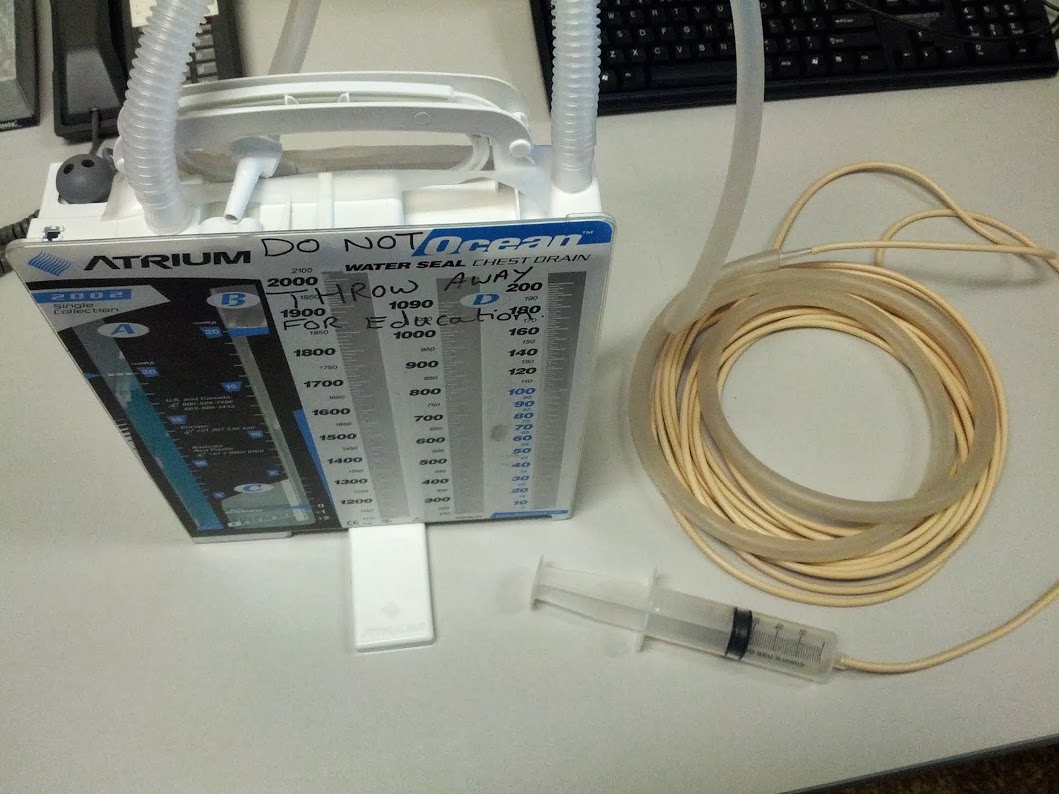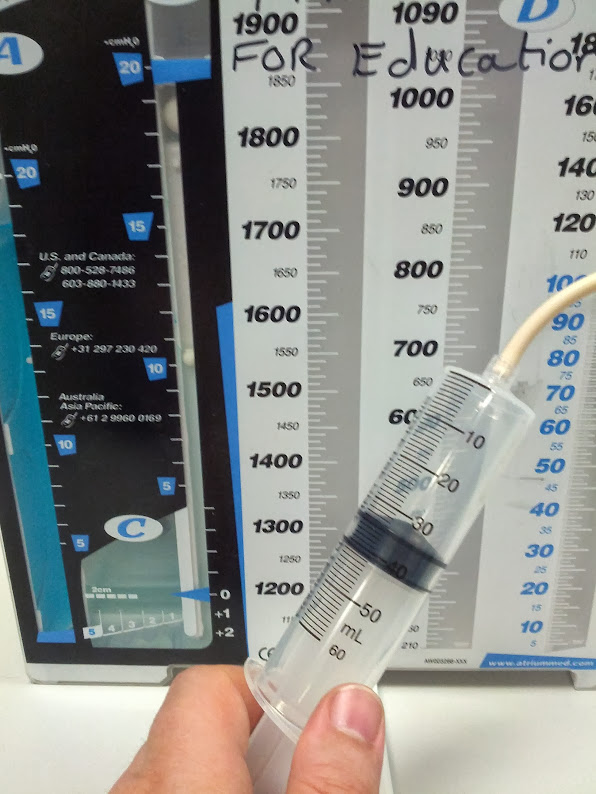Recently, I received a request to develop a simulation involving a chest drain on SimMan Classic. I thought I had seen some posts somewhere on how others had done this. Here’s one post from the SimGhosts 2012 DIY Video contest.
I also referred to some excellent material from SimCentral. Their SuperAnnie 3 product seems really good, and there’s some good chest tube info there. However, as usual, I needed a solution that was really cheap and available instantly.
The scenario being planned needed to show swinging in the drain and ideally some bubbling. Chest tube insertion wasn’t an issue, it was already in place. We have the Ocean 2002 UWSD from Atrium. Much to my delight, it still had blue dye in the chambers. Not sure if this one had ever been used. Hooking up to suction caused bubbling in chamber A (suction control). Blocking off the drain line brought the bubbling under control and I could adjust the suction to get just a trickle of bubbles. Attaching a 60 mL syringe to the end of the drain line provided enough volume change to move the ‘bubble & swing’ ball in chamber B throughout its range. The beige irrigation tubing I mentioned in the IV Setup post fits nicely on luer fittings. I used a whole roll (10m) on the end of the drain and the 60 mL syringe worked fine. This will let me put the syringe in the control room for remote activation.



A dual size adapter I found in the cupboard made a very neat connection between the drain and the long irrigation tube.

Adding a Y connector and an IV roller clamp as suggested by the SimGhosts video allows for a variable air leak. Put the roller clamp near the free end of the tubing so you can cut off bits as the tubing gets crushed over time.

I visited ICU this afternoon to get some personal experience with chest drain swinging and bubbling – not something I normally see as a paramedic. In a drain setup without suction, spontaneous inhalation will cause, the ball and water column in chamber B to rise. This will be more pronounced the larger the breath and the larger the pleural space. Generally, this swing can be around 10 – 15 cm up the column (negative pressure). Apparently, patients with asthma can draw 50-60 cm water – hence the long drain tube and the low placement of the drain below the patient. Remember, these are pleural pressures, not lung pressures, although they are related.
In patients who are externally ventilated, the pressures are generally positive (i.e. positive pressure ventilation). This is particularly true of patients who have a PEEP (positive end expiratory pressure) set on their ventilators. This keeps the pressure in the lungs always positive. But what is happening in the pleural space depends on its volume. Gas (a compressible fluid) in the pleural space will transmit pressures from the lungs. As the pneumothorax is resolved and the volume of the pleural space approaches zero, the pressure transmitted into the chest tube will decrease to zero on positive pressure ventilation. The pleural space pressure is limited by a relief valve in the drain and the height of the water in the bubble chamber C. Large positive pressures in the pleural space are bad (tension pneumothorax).
With suction applied to the drain apparatus, the reference point is decreased to the level of vacuum being applied. Thus the pressure in the pleural space (relative to atmospheric) is -20 cm H2O + whatever is shown in column B (negative for spontaneous ventilation and generally slightly positive for external ventilation).
What this all means is that the changes I can make to the drain display with my big syringe and variable leak from the control room will closely mimic what actually happens.
Operation of this system involves moving the syringe plunger with each spontaneous breath or setting a slightly positive pressure when externally ventilated. It would be nice to integrate this somehow with the SimMan pneumatics to operate automatically. I’ll post an update if/when I work this feature out.